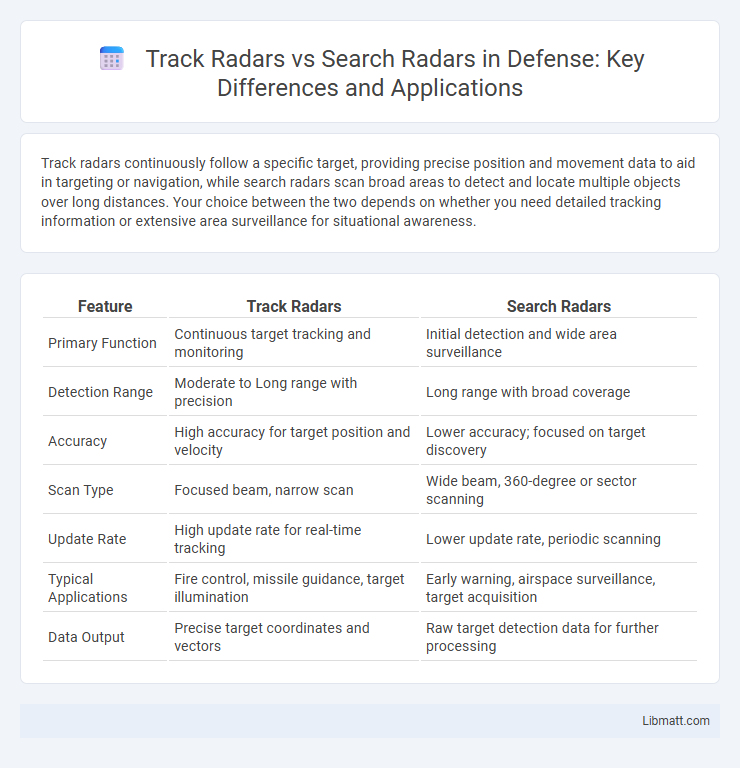Track radars continuously follow a specific target, providing precise position and movement data to aid in targeting or navigation, while search radars scan broad areas to detect and locate multiple objects over long distances. Your choice between the two depends on whether you need detailed tracking information or extensive area surveillance for situational awareness.
Table of Comparison
| Feature | Track Radars | Search Radars |
|---|---|---|
| Primary Function | Continuous target tracking and monitoring | Initial detection and wide area surveillance |
| Detection Range | Moderate to Long range with precision | Long range with broad coverage |
| Accuracy | High accuracy for target position and velocity | Lower accuracy; focused on target discovery |
| Scan Type | Focused beam, narrow scan | Wide beam, 360-degree or sector scanning |
| Update Rate | High update rate for real-time tracking | Lower update rate, periodic scanning |
| Typical Applications | Fire control, missile guidance, target illumination | Early warning, airspace surveillance, target acquisition |
| Data Output | Precise target coordinates and vectors | Raw target detection data for further processing |
Introduction to Track Radars and Search Radars
Track radars continuously monitor and lock onto specific targets, providing precise location and movement data crucial for guidance and targeting systems. Search radars scan wide areas to detect and locate multiple objects simultaneously, serving as an early warning and situational awareness tool. Understanding the distinct functions of track radars versus search radars enhances your ability to select the right radar technology for surveillance or defense applications.
Fundamental Principles of Radar Technology
Track radars continuously monitor a specific target's position and velocity by maintaining a focused beam, enabling precise trajectory prediction and target engagement. Search radars employ a rotating or electronically scanned beam to cover a wide area, detecting multiple targets by rapidly scanning the environment. Both systems utilize electromagnetic wave reflection principles, but track radars emphasize high accuracy and target discrimination, while search radars prioritize broad surveillance and initial detection.
Key Differences Between Track and Search Radars
Track radars continuously monitor and lock onto specific targets, providing precise location, speed, and trajectory data crucial for missile guidance and threat assessment. Search radars scan wide areas to detect and locate multiple targets, offering broad situational awareness but less detailed tracking information. Understanding these key differences helps you choose the right radar system based on the required detection range, accuracy, and real-time tracking capabilities.
Functional Roles in Military and Civilian Applications
Track radars specialize in continuously monitoring specific targets to provide precise positional data, critical for missile guidance and air defense systems in military operations. Search radars scan broader areas to detect and locate multiple objects simultaneously, playing a vital role in air traffic control and early warning in civilian and military contexts. Your choice between these radar types depends on whether you need focused tracking for specific threats or wide-area surveillance for situational awareness.
Range and Accuracy: A Comparative Analysis
Track radars typically offer higher accuracy by continuously monitoring and predicting target trajectories, enabling precise tracking within a reduced range compared to search radars. Search radars provide a broader detection range, scanning large areas to locate multiple targets, but with comparatively lower resolution and accuracy for individual object tracking. The key distinction lies in the trade-off between the expansive range of search radars and the pinpoint accuracy of track radars, essential for applications requiring detailed target information.
Response Time and Target Acquisition Capabilities
Track radars feature faster response times and maintain continuous lock-on, ensuring precise target tracking and real-time updates critical for missile guidance. Search radars cover broader areas with slower response times, optimizing initial target acquisition across multiple targets but with less immediate precision. Your choice between track and search radars depends on whether rapid response or wide-area surveillance is prioritized for your radar system.
Technological Variations: Antenna Design and Signal Processing
Track radars feature electronically steered phased array antennas enabling rapid beam steering for continuous target tracking, while search radars typically use mechanically rotating parabolic antennas optimized for wide-area surveillance. Signal processing in track radars employs sophisticated algorithms such as Kalman filtering and Doppler processing to maintain precise target trajectories, whereas search radars focus on detecting multiple targets with pulse compression and range-Doppler techniques. These technological variations reflect the specialized roles of track radars in precision engagement and search radars in broad situational awareness.
Advantages and Limitations of Track Radars
Track radars provide precise target tracking by continuously monitoring specific objects, enabling real-time data updates crucial for missile guidance and air traffic control. Their main advantage is maintaining an accurate lock on targets despite maneuvers, but limitations include reduced coverage area compared to search radars and higher susceptibility to signal jamming. Optimizing your radar system involves balancing the high-resolution tracking capabilities of track radars with the broad situational awareness offered by search radars.
Advantages and Limitations of Search Radars
Search radars provide broad-area surveillance with the ability to detect multiple targets simultaneously, making them essential for initial target acquisition and situational awareness. Their limitations include lower precision in target positioning compared to track radars, which can affect accuracy when engaging fast-moving or maneuvering targets. Search radars often have slower update rates and less detailed tracking data, requiring handoff to track radars for precise target monitoring and engagement.
Future Trends in Radar Systems Integration
Future trends in radar systems integration emphasize the convergence of track radars and search radars into unified platforms capable of seamless data fusion for enhanced situational awareness. Artificial intelligence and advanced signal processing algorithms will improve target detection accuracy and reduce false alarms, empowering your radar systems to adapt dynamically to complex environments. Integration efforts are driving compact, multi-function radar designs that support network-centric warfare and autonomous operations.
track radars vs search radars Infographic

 libmatt.com
libmatt.com